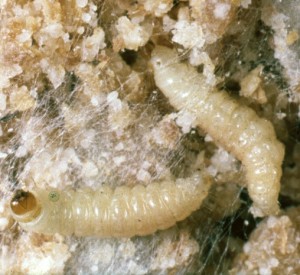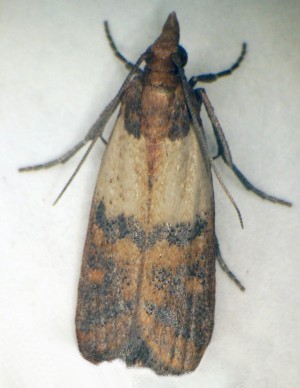Indianmeal Moth
 Scientific Name
Scientific Name
Plodia interpunctella
Symptoms
The Indianmeal moth is one of the most common and troublesome of moths infesting stored food products. The caterpillars cause all of the damage. The larvae infest a wide variety of food products, especially those of plant origin. They have been found in stored grains, flour, cornmeal, nuts, dried fruits, powdered milk, candy, chili pepper, fish food, dry dog and cat food, seeds, and chocolate.
Life Cycle
 Females begin to lay eggs on larval food materials about three days after emergence.
Each female can lay 200 to 400 eggs over a period of 1 to 18 days. The eggs hatch
in 2 to 14 days and the larvae begin building the silk and frass tunnels in which
they live and feed. Food products often become matted with their silken webbing. Larvae
mature in 4 to 5 weeks and often wander away from the food source in search of pupation
sites. The pupal period is about 2 weeks. The entire life cycle can be completed in
6 to 8 weeks under favorable conditions.
Females begin to lay eggs on larval food materials about three days after emergence.
Each female can lay 200 to 400 eggs over a period of 1 to 18 days. The eggs hatch
in 2 to 14 days and the larvae begin building the silk and frass tunnels in which
they live and feed. Food products often become matted with their silken webbing. Larvae
mature in 4 to 5 weeks and often wander away from the food source in search of pupation
sites. The pupal period is about 2 weeks. The entire life cycle can be completed in
6 to 8 weeks under favorable conditions.
Description
Adult moths are about 3/8 inch long when at rest and have a 3/4 inch wingspread. The front wings are brick red on the outer two-thirds and light grayish brown on the inner one-third. The head and thorax are red brown and the hindwings are gray. Larvae are dirty white, often with a pinkish or greenish tint, and have brown heads. They are about 1/2 inch long when mature.
Control
Locate the source of the infestation! Carefully examine all susceptible foods and other stored products that may have been exposed to the infestation. This includes all pet foods and seeds. Do not overlook unopened paper and cellophane wrapped products, as the insects may even be found in these. You will probably want to throw away all infested products.
Contents from all packages which appear to be uninfested should be transferred to glass or plastic containers with tight-fitting lids. It is possible that eggs were laid in these products and that they may hatch later and lead to an infestation if not contained. Glass containers make periodic examination of the food easier.
Lightly infested foods or food products where there are questionable infestations can be heated in shallow pans in the oven at 130-150 F for 30 minutes (or use a preheat setting of 30 to 45 seconds in a microwave oven) or placed in a deep freezer at 0 F for seven to ten days. Sifting the food material will remove most of the insect fragments and any remaining will not cause harm if consumed. Heat-treat dried fruits by placing in a cheesecloth bag and dipping in boiling water for about six seconds.
Remove all food, food containers and utensils from the infested areas and clean thoroughly, first with a vacuum cleaner and then with soap and water. Special attention should be paid to cracks, crevices and corners (including under and behind appliances) were bits of flour, meal or other food may have accumulated.
It is not recommend using an insecticide.

